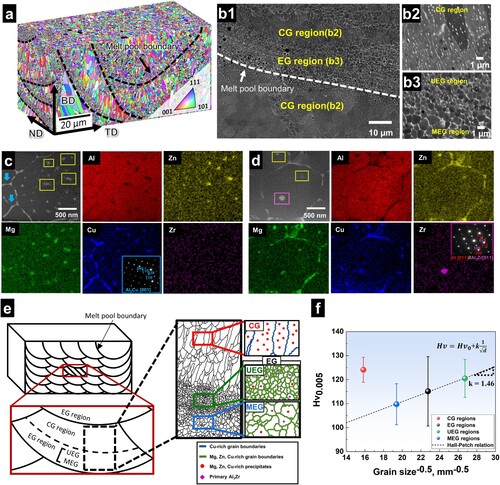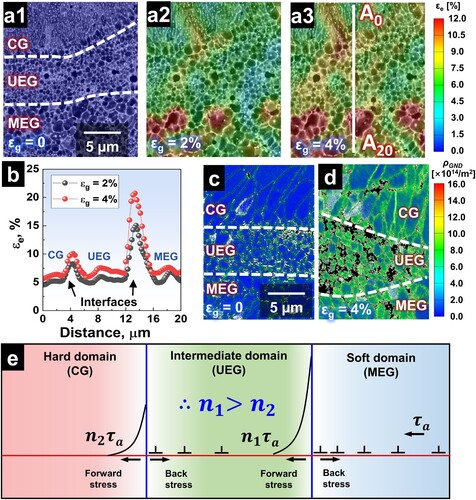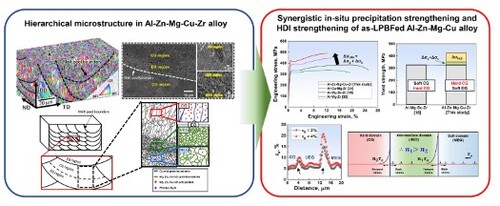Figures & data
Figure 1. (a) EBSD inverse pole figure map of the as-built alloy. (b1) BSE image of the boundary between CG and EG regions. High-magnification BSE image of (b2) CG and (b3) EG regions. TEM-EDS results for (c) CG and (d) EG regions. SAED patterns in (c) and (d) correspond to the diffraction patterns of θ-Al2Cu and L12-Al3Zr, respectively. (e) Schematic of grain morphology and distribution of precipitates in the Al–Zn–Mg–Cu–Zr alloy. (f) Hardness measurement results at each region in as-built Al–Zn–Mg–Cu–Zr alloy.

Figure 2. Tensile test results of as-built Al–Zn–Mg–Cu–Zr alloy and other as-built Al alloys with inoculants [Citation18,Citation24,Citation32].
![Figure 2. Tensile test results of as-built Al–Zn–Mg–Cu–Zr alloy and other as-built Al alloys with inoculants [Citation18,Citation24,Citation32].](/cms/asset/10171da8-9efb-41e5-b90b-930b70d43d64/tmrl_a_2354757_f0002_oc.jpg)
Figure 3. (a) Micro digital image correlation results. (a1), (a2), and (a3) Local equivalent strain (εe) maps at the initial state and the global strains of 2% and 4%, respectively. (b) Line profile of εe from A0 to A20 along the white line in Figure (a3). (c) and (d) GNDs density maps of the initial state and at the global strains of 4%, respectively. (e) Schematic of the accumulation of GNDs at the interfaces.

Table 1. Average equivalent strains in each domain.
Figure 4. Tensile test results for as-built Al–Zn–Mg–Cu–Zr alloy. (a) True strain–stress curve of the LUR test. (b) HDI stress and effective stress of Al–Zn–Mg–Cu–Zr and Al–Mg–Sc–Zr [Citation18]. alloys, respectively. (c) YSs of Al–Mg–Sc–Zr [Citation18] and Al–Zn–Mg–Cu–Zr alloys. (d) Ashby plot of as-built Al–Zn–Mg–Cu–Zr, Al–Zn–Mg–Cu–Sc–Zr [Citation7], Al–Cu–Mg–Zr [Citation24,Citation38,Citation39], Al–Mg–Sc–Zr [Citation18,Citation40], and Al–Mg–Zr alloys [Citation32].
![Figure 4. Tensile test results for as-built Al–Zn–Mg–Cu–Zr alloy. (a) True strain–stress curve of the LUR test. (b) HDI stress and effective stress of Al–Zn–Mg–Cu–Zr and Al–Mg–Sc–Zr [Citation18]. alloys, respectively. (c) YSs of Al–Mg–Sc–Zr [Citation18] and Al–Zn–Mg–Cu–Zr alloys. (d) Ashby plot of as-built Al–Zn–Mg–Cu–Zr, Al–Zn–Mg–Cu–Sc–Zr [Citation7], Al–Cu–Mg–Zr [Citation24,Citation38,Citation39], Al–Mg–Sc–Zr [Citation18,Citation40], and Al–Mg–Zr alloys [Citation32].](/cms/asset/595f4af5-feee-4a81-9a7d-6cd17b203c68/tmrl_a_2354757_f0004_oc.jpg)

